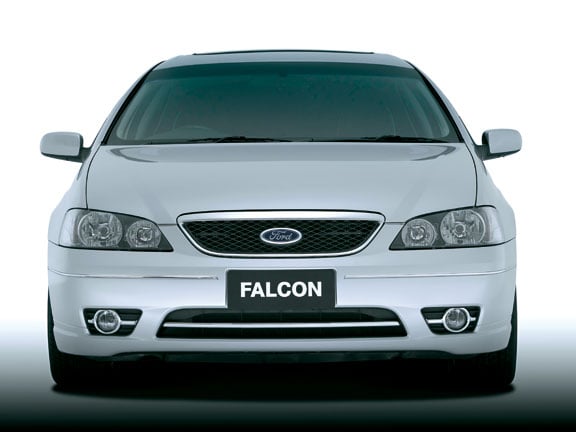
The idea of dressing up a mainstream family car and making it into something rather more special is nothing new. But is the Falcon-based Ford Fairmont little more than a silk purse crafted from a sow’s ear? Certainly this upmarket version of a big, everyday model has enduring power. Last year the Fairmont celebrated its 40th birthday. In fact, when the first XP series Fairmont arrived in 1965, the Australian Falcon had only been around for five years.
The XP was the fourth generation Falcon and the first Australian manufactured car to win the Wheels magazine Car of the Year award. The Fairmont arrived six months after the launch of the XP and was noted for being the first Australian-made car to have front disc brakes as standard. It also had a level of equipment never seen before in an Aussie car, including reclining seats. Since then, the Fairmont has always been regarded as a premium Falcon, and it’s a model that has done particularly well in New Zealand. Yet fitting some special wheels, adding some wood trim and leather seating is never going to transform the basic Falcon into a luxury car. What it does is provide a little more distinction and comfort to what is already a good value package. Holden does the same with the Calais which develops an identical 190kW engine output and is priced within $90 of the Fairmont Ghia’s $61,990. You can pay a more modest $50,690 for a regular Fairmont or as little as $44,790 for an entry-level Falcon XT auto that has the same uprated 4.0-litre six-cylinder engine. At today’s exchange rates, the Fairmont Ghia is actually cheaper in New Zealand than Australia. But the implication of our lower dollar is an end to the long period of price stability.
The Falcon XT retains the older four-speed automatic rather than the new German ZF six-speed transmission and 16-inch diameter steel wheels instead of the Ghia’s wider 17-inch alloys shod with 225/50 series tyres. A regular Fairmont has the same 215/60 tyres as the XT but they’re fitted to 16-inch alloy wheels. And, in the interests of ride comfort, the Ghia dismisses the lower profile 235/45 tyres used on the XR6 models. Even so, the ride is quite firm and busy at urban speeds, taking an edge off the luxury image. The nine-spoke alloys have machined front faces and Ghia scripts on the centre caps.
When the BF series appeared last year it was obvious Ford wasn’t making a visual distinction between the latest Falcon/Fairmont and its predecessor. Almost all the changes are under the skin. The Fairmont has new front graphics and foglights that replace the cornering lamps on the BA Mark II. And though a bootlid spoiler might be the kit for an XR6 or an FPV GT Falcon, I can’t fathom why it should find a place on a Fairmont. It’s out of character and spoils the look of the rear end. You need to be a keen Ford spotter to notice the chrome highlights across the front and rear bumpers and along the bodyside protection mouldings, or the full width chrome strip segments around the lower grille opening and foglight surrounds. New bumpers, new taillights, soft-feel door handles with satin chrome inserts, new finish on the facia and centre console plus woodgrain trim are BF Fairmont traits.
Yet the engineering changes are the most significant. Dual independent variable camshaft timing and dual knock sensors have increased power and torque while the sequential sports shifting six-speed auto is calibrated specifically for the BF. Even the older four-stage auto now has grade control logic that aids braking and speed control when descending steep roads. The transmission is smooth and responsive, and the manual override a boon.
The car is quick and smooth, accelerating from 50 to 80km/h in less than four seconds, and easing along at 100km/h with a mere 1600 revs on the dial. There’s good weighting to the steering and the control blade independent rear suspension rewards the driver with sharp and predictable handling and accurate roadholding.
The BF’s cabin is a quiet and comfortable place to be. It has better sealing than its predecessor and extra body strengthening, and the Ghia incorporates new sound dampening that targets rear seat quietness. Sound deadening learnt from the Territory, new buffers and changes to the exhaust have helped produce a five decibel reduction in high frequency noise at open road speeds. Dynamic Stability Control (DSC) is standard on the Ghia. The XR6 Turbo and XR8 are the only other BF Falcon models to include this feature. Ford buyers back in the mid-1960s could never have imagined this sort of sophistication in their new Fairmont. DSC uses the braking and electronic control unit to control a skid. A steering wheel sensor constantly monitors steering wheel angle, direction of travel, acceleration and lateral motion. The DSC sensors monitor 25 times a second, compared to 50 times a second for the traction control system and 200 times a second for the improved Bosch anti-lock brakes. By checking throttle position, braking and the direction of the car, DSC intervenes early enough to reduce slides and potential loss of control. The system also modulates engine output and reduces wheelspin and vehicle speed.
DSC is set to kick in earlier than in other BF Falcons. At the same time, in line with the sportier image of the Fairmont, the system intervenes slightly later than it does in the long wheelbase Fairlane and LTD models. The Fairmont shares the same excellent dashboard and controls of the cheaper Falcon while adding a plushness that belies the pricetag. This car is commendably roomy and comfortable, but that low roofline means you still need to take care when entering or exiting the cabin. Its popularity is legendary – in April Falcon/Fairmont captured 33 percent of New Zealand’s large car segment. BF is clearly an institution with a large membership.